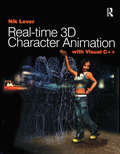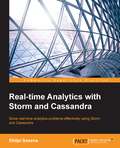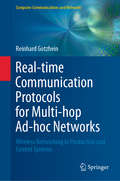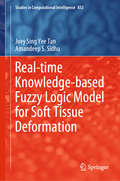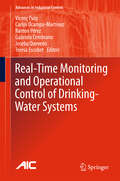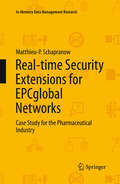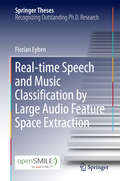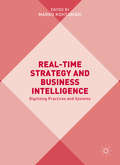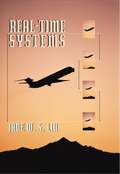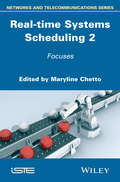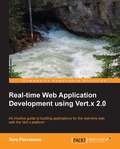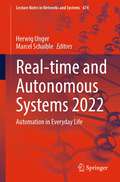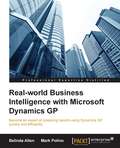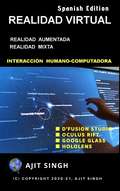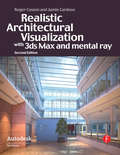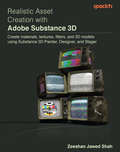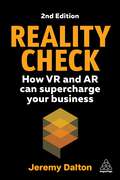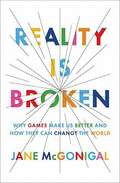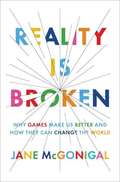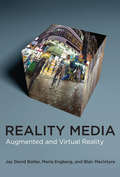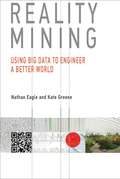- Table View
- List View
Real-time 3D Character Animation with Visual C++
by Nik LeverDo you have some experience and a reasonable knowledge of C++ and want to write your own computer games? Have you ever looked at a PC or Playstation (R) game with characters running and leaping through an exciting landscape and wondered how it was done? If so then this book will give you all the information you need to achieve this goal, whether you are a hobby programmer, student or even a professional wanting to add that third dimension to your website.Nik Lever takes you through the journey from the basics of 3D manipulation all the way to morph objects and sub-division surfaces. On the way you get Visual C++ project files to study and software that runs on the Windows desktop. The free CD-ROM gives you a full-featured development environment for 3D character animation, so even if you find some of the maths and the code hard to follow straight away you can still create your own games. The game engine (Toon3DCreator) provided free and fully functional on the CD-ROM, even has an ActiveX control that allows you to distribute your work on the Internet. All source code for Toon3D is included on the CD. You will also get an insight into the artist's problems; learn how to keep the characters interesting while not exhausting the game engine. Understand the complete picture and make the most of your skills to help you succeed in, or break into the computer gaming industry with this comprehensive guide to programming for real-time 3D character animation.
Real-time Analytics with Storm and Cassandra
by Shilpi SaxenaIf you want to efficiently use Storm and Cassandra together and excel at developing production-grade, distributed real-time applications, then this book is for you. No prior knowledge of using Storm and Cassandra together is necessary. However, a background in Java is expected.
Real-time Communication Protocols for Multi-hop Ad-hoc Networks: Wireless Networking in Production and Control Systems (Computer Communications and Networks)
by Reinhard GotzheinThis book focuses on core functionalities for wireless real-time multi-hop networking with TDMA (time-division multiple access) and their integration into a flexible, versatile, fully operational, self-contained communication system. The use of wireless real-time communication technologies for the flexible networking of sensors, actuators, and controllers is a crucial building block for future production and control systems. WirelessHART and ISA 100.11a, two technologies that have been developed predominantly for industrial use, are currently available. However, a closer analysis of these approaches reveals certain deficits. Current research on wireless real-time communication systems shows potential to remove these limitations, resulting in flexible, versatile, and robust solutions that can be implemented on today’s low-cost and resource-constrained hardware platforms. Unlike other books on wireless communication, this book presents protocols located on MAC layer and above, and build on the physical (PHY) layer of standard wireless communication technologies.
Real-time Knowledge-based Fuzzy Logic Model for Soft Tissue Deformation (Studies in Computational Intelligence #832)
by Amandeep S. Sidhu Joey Sing TanThis book provides a real-time and knowledge-based fuzzy logic model for soft tissue deformation. The demand for surgical simulation continues to grow, as there is a major bottleneck in surgical simulation designation and every patient is unique. Deformable models, the core of surgical simulation, play a crucial role in surgical simulation designation. Accordingly, this book (1) presents an improved mass spring model to simulate soft tissue deformation for surgery simulation; (2) ensures the accuracy of simulation by redesigning the underlying Mass Spring Model (MSM) for liver deformation, using three different fuzzy knowledge-based approaches to determine the parameters of the MSM; (3) demonstrates how data in Central Processing Unit (CPU) memory can be structured to allow coalescing according to a set of Graphical Processing Unit (GPU)-dependent alignment rules; and (4) implements heterogeneous parallel programming for the distribution of grid threats for Computer Unified Device Architecture (CUDA)-based GPU computing.
Real-time Monitoring and Operational Control of Drinking-Water Systems
by Vicenç Puig Carlos Ocampo-Martínez Ramon Pérez Gabriela Cembrano Joseba Quevedo Teresa EscobetThis book presents a set of approaches for the real-time monitoring and control of drinking-water networks based on advanced information and communication technologies. It shows the reader how to achieve significant improvements in efficiency in terms of water use, energy consumption, water loss minimization, and water quality guarantees. The methods and approaches presented are illustrated and have been applied using real-life pilot demonstrations based on the drinking-water network in Barcelona, Spain. The proposed approaches and tools cover: * decision-making support for real-time optimal control of water transport networks, explaining how stochastic model predictive control algorithms that take explicit account of uncertainties associated with energy prices and real demand allow the main flow and pressure actuators--pumping stations and pressure regulation valves-- and intermediate storage tanks to be operated to meet demand using the most sustainable types of source and with minimum electricity costs; * decision-making support for monitoring water balance and distribution network quality in real time, implementing fault detection and diagnosis techniques and using information from hundreds of flow, pressure, and water-quality sensors together with hydraulic and quality-parameter-evolution models to detect and locate leaks in the network, possible breaches in water quality, and failures in sensors and/or actuators; * consumer-demand prediction, based on smart metering techniques, producing detailed analyses and forecasts of consumption patterns, providing a customer communications service, and suggesting economic measures intended to promote more efficient use of water at the household level. Researchers and engineers working with drinking-water networks will find this a vital support in overcoming the problems associated with increased population, environmental sensitivities and regulation, aging infrastructures, energy requirements, and limited water sources.
Real-time Security Extensions for EPCglobal Networks: Case Study for the Pharmaceutical Industry
by Matthieu-P. SchapranowThe transformation towards EPCglobal networks requires technical equipment for capturing event data and IT systems to store and exchange them with supply chain participants. For the very first time, supply chain participants thus need to face the automatic exchange of event data with business partners. Data protection of sensitive business secrets is therefore the major aspect that needs to be clarified before companies will start to adopt EPCglobal networks. This book contributes to this proposition as follows: it defines the design of transparent real-time security extensions for EPCglobal networks based on in-memory technology. For that, it defines authentication protocols for devices with low computational resources, such as passive RFID tags, and evaluates their applicability. Furthermore, it outlines all steps for implementing history-based access control for EPCglobal software components, which enables a continuous control of access based on the real-time analysis of the complete query history and a fine-grained filtering of event data. The applicability of these innovative data protection mechanisms is underlined by their exemplary integration in the FOSSTRAK architecture.
Real-time Speech and Music Classification by Large Audio Feature Space Extraction
by Florian EybenThis book reports on an outstanding thesis thathas significantly advanced the state-of-the-art in the automated analysis andclassification of speech and music. Itdefines several standard acoustic parameter sets and describes theirimplementation in a novel, open-source, audio analysis framework calledopenSMILE, which has been accepted and intensively used worldwide. The bookoffers extensive descriptions of key methods for the automatic classificationof speech and music signals in real-life conditions and reports on theevaluation of the framework developed and the acoustic parameter sets that wereselected. It is not only intended as a manual for openSMILE users, but also andprimarily as a guide and source of inspiration for students and scientists involvedin the design of speech and music analysis methods that can robustly handlereal-life conditions.
Real-time Strategy and Business Intelligence
by Marko KohtamäkiThis book discusses and conceptualizes practices on real-time strategy, focusing on the interplay between strategy and business intelligence. Combining strategic practices and business intelligence systems, the authors demonstrate how managerial practices can be developed in the age of digitization. Also developing the concept of strategic agility, the book provides perspectives from a range of disciplines including strategic practices and decision making, customer relationship management, human resource management, competitive intelligence, supplier network management and business intelligence systems. Presenting managerial frameworks and guidelines, Real-time Strategy and Business Intelligence explores how to improve utilization of business intelligence systems in real-time decision making. Providing practical and future-oriented insights backed by examples and best practices, the authors present a clearly conceptualized theoretical framework.
Real-time Systems
by Jane W. S. LiuWritten by a renowned authority, this advanced text comprehensively covers the advances in real-time operating systems and communications networks, emphasizing research results that have been adopted in state-of-the-art systems.
Real-time Systems Scheduling 1: Fundamentals
by Maryline ChettoReal-time systems are used in a wide range of applications, including control, sensing, multimedia, etc. Scheduling is a central problem for these computing/communication systems since responsible of software execution in a timely manner. This book provides state of knowledge in this domain with special emphasis on the key results obtained within the last decade. This book addresses foundations as well as the latest advances and findings in Real-Time Scheduling, giving all references to important papers. But nevertheless the chapters will be short and not overloaded with confusing details. Coverage includes scheduling approaches for mono-core as well as multi-core platforms, dependent tasks, networks, and notably very tremendous recent advances in scheduling of energy constrained embedded systems. Other sophisticated issues such as feedback control scheduling and timing analysis of critical applications are also addressed. This volume can serve as a textbook for courses on the topic in bachelor and in more advanced master programs. It also provides a reference for computer scientists and engineers involved in the design or the development of Cyber-Physical Systems which require up-to-date real-time scheduling solutions.
Real-time Systems Scheduling 2
by Maryline ChettoReal-time systems are used in a wide range of applications, including control, sensing, multimedia, etc. Scheduling is a central problem for these computing/communication systems since it is responsible for software execution in a timely manner. This book, the second of two volumes on the subject, brings together knowledge on specific topics and discusses the recent advances for some of them. It addresses foundations as well as the latest advances and findings in real-time scheduling, giving comprehensive references to important papers, but the chapters are short and not overloaded with confusing details. Coverage includes scheduling approaches for networks and for energy autonomous systems. Other sophisticated issues, such as feedback control scheduling and probabilistic scheduling, are also addressed.This book can serve as a textbook for courses on the topic in bachelor's degrees and in more advanced master's degree programs. It also provides a reference for computer scientists and engineers involved in the design or the development of Cyber-Physical Systems which require up-to-date real-time scheduling solutions.
Real-time Web Application Development using Vert.x 2.0
by Tero ParviainenA quick, clear, and concise tutorial-guide-based approach that helps you to develop a web application based on Vert.x.Real-time Web Application Development with Vert.x is written for web developers who want to take the next step and dive into real-time web application development.This book uses JavaScript (and some Java) to introduce the Vert.x platform, so basic JavaScript knowledge is expected. If you're planning to write your applications using some of the other Vert.x languages, all the techniques and concepts will translate to them directly. All you need to do is refer to the Vert.x API reference documentation to see the particular APIs for your language.
Real-time and Autonomous Systems 2022: Automation in Everyday Life (Lecture Notes in Networks and Systems #674)
by Herwig Unger Marcel SchaibleThis book contains the results of the researchers presented at this conference, which is supported by German Society of informatics (GI) and other organisations Real-Time Systems Expert Committees. The 43rd Real-Time Systems conference on "Automation in Everyday Life" is addressing an increasingly important topic in a world that is becoming more and more networked. The solutions presented here range from hardware to system design to individual applications. The target audience is students and researchers in computer science and automation technology (partly electrical engineering), engineers, programmers and users of automation and communication systems.
Real-world Business Intelligence with Microsoft Dynamics GP
by Belinda Allen Polino MarkIf you're a GP user, this book is aimed at making your job easier. How? Through the use of Business Intelligence (BI) provided by your Microsoft Dynamics GP software to aid you in making informed decisions. This book assumes no previous experience; however, a basic knowledge of Excel is expected.
Realidad Virtual
by Ajit SinghEl rápido desarrollo de la tecnología la ha vuelto omnipresente. La computadora es el producto más representativo, ya que en unas pocas décadas ha logrado una amplia aceptación. Ahora bien, hay muchas clases diferentes de computadoras, por ejemplo, el enorme servidor ubicado en la habitación, la computadora personal en la mesa, la computadora portátil, el teléfono inteligente y la tableta e incluso el dispositivo portátil en nuestra muñeca o en nuestra cabeza. La relación entre la computadora y el ser humano ha atravesado por un cambio fundamental. La interacción ente el hombre y la computadora (IHC) es un campo de estudio que ayuda a las personas a controlar las máquinas con mayor facilidad, de modo que una gran variedad de usuarios pueden utilizar las computadoras, desde una minoría especializada hasta la gran mayoría de las personas en todo el mundo. La ACM define a la IHC como "Una disciplina relacionada con el diseño, evaluación e implementación de sistemas informáticos interactivos y el estudio de los principales fenómenos que los rodean". (Hewett et al., 2009). En sus inicios, solo podíamos escribir el comando para que la computadora funcionara, luego, después del desarrollo de la interfaz gráfica, con el nacimiento del mouse, comenzamos a hacer clic en los íconos. En los últimos años, la tecnología de la pantalla táctil ha liberado nuestra mano y ya podemos tocar la pantalla para usar nuestro dispositivo. Aún así, se siguen investigando nuevas formas de interacción. Oculus Rift, Google Glass y HoloLens representan la tecnología más avanzada en el campo de la Realidad virtual / Realidad aumentada. Las personas repiten tediosas actividades cotidianas y se sienten aburridas. ¿Hay alguna manera de hacer que el mundo real esté lleno de variedad? Este libro presentará la historia y el desarrollo de la interacción humano-computadora y la Realidad virtual / Realidad aumentada. Analizará las tres tecnologías m�
Realistic Architectural Visualization with 3ds Max and mental ray
by Jamie Cardoso Roger CussonRevitalize your architectural visualizations by bringing new levels of realism to them with an enhanced command of the mental ray toolset in 3ds Max. Full-color step-by-step tutorials give you a firm understanding of the processes and techniques needed to create impressive interior and exterior visualizations. You'll learn how to prepare materials, light a daytime interior scene, use mr Physical Sky, and how to save time during complex renders. The companion website includes all of the tutorial files and sample files from the book.
Realistic Asset Creation with Adobe Substance 3D: Create materials, textures, filters, and 3D models using Substance 3D Painter, Designer, and Stager
by Zeeshan Jawed ShahGain extensive, practical knowledge of 3D design with Adobe Substance 3D and learn to build a comprehensive portfolio of work with this interactive bookKey FeaturesFind out how to use Adobe Substance 3D swiftly and with little prior knowledgeUse a variety of interactive projects to get familiar with the fundamentalsCreate better career prospects for yourself by mastering 3D design with a single comprehensive guideBook DescriptionAdobe Substance 3D is a comprehensive suite complete with everything an artist needs to create stunning 3D digital materials. Getting a grip on the ecosystem of apps can be challenging for beginners, which is where Realistic Asset Creation with Adobe Substance 3D comes in!This practical guide doesn't bombard you with reams of textual information. Instead, you get an interactive, project-based book that'll help you gain sound knowledge of Adobe Substance 3D and set you on the right path toward a career in 3D design. You'll start off with the rudiments of Adobe Substance 3D Painter, which will enable you to acquire the skills needed to work with layers, masks, shelves, textures, and more. Next, you'll move on to Adobe Substance 3D Designer and become well-acquainted with this node-based design tool as you progress through the chapters. The final section is devoted to Adobe Substance 3D Stager, which teaches you to build complex 3D scenes and visualize your edits in real time.By the end of this Adobe book, you'll have gained a solid understanding of Adobe Substance 3D and developed the skills to build a comprehensive portfolio of work, setting you up for a lucrative career in 3D design.What you will learnDiscover Substance 3D Painter, Designer, and Stager through easy projectsAssemble 3D scenes and set up assets, materials, lights, and camerasExplore the innovative 3D assets library and learn how to digitize your 3D assetsTexture your 3D assets with advanced brushes and Smart MaterialsUse and blend a variety of nodes in Adobe Substance 3D DesignerCreate and export materials using Adobe Substance 3D SamplerWho this book is forThis book is for game designers, 3D generalists, and design students. If you're looking to get started in your 3D career or planning to join 3D generation, then you'll find this book useful. The book assumes very little to no 3D design knowledge. A bit of understanding of the history, functionality, and purpose of the Adobe Substance 3D package is presumed but is not mandatory; however, you must know how to work with Adobe Photoshop.
Realistic Asset Creation with Adobe Substance 3D: Create materials, textures, filters, and 3D models using Substance 3D Painter, Designer, and Stager
by Zeeshan Jawed ShahGain extensive, practical knowledge of 3D design with Adobe Substance 3D and learn to build a comprehensive portfolio of work with this illustrated guideKey FeaturesFind out how to use Adobe Substance 3D swiftly and with little prior knowledgeUse a variety of interactive projects to get familiar with the fundamentalsCreate better career prospects for yourself by mastering 3D design with a single comprehensive guideBook DescriptionAdobe Substance 3D is a comprehensive suite complete with everything an artist needs to create stunning 3D digital materials. Getting a grip on the ecosystem of apps can be challenging for beginners, which is where Realistic Asset Creation with Adobe Substance 3D comes in! This practical guide doesn't bombard you with reams of textual information. Instead, you get an interactive, project-based book that’ll help you gain sound knowledge of Adobe Substance 3D and set you on the right path toward a career in 3D design. You’ll start off with the rudiments of Adobe Substance 3D Painter, which will enable you to acquire the skills needed to work with layers, masks, shelves, textures, and more. Next, you’ll move on to Adobe Substance 3D Designer and become well-acquainted with this node-based design tool as you progress through the chapters. The final section is devoted to Adobe Substance 3D Stager, which teaches you to build complex 3D scenes and visualize your edits in real time. By the end of this Adobe book, you’ll have gained a solid understanding of Adobe Substance 3D and developed the skills to build a comprehensive portfolio of work, setting you up for a lucrative career in 3D design.What you will learnDiscover Substance 3D Painter, Designer, and Stager through easy projectsAssemble 3D scenes and set up assets, materials, lights, and camerasExplore the innovative 3D assets library and learn how to digitize your 3D assetsTexture your 3D assets with advanced brushes and Smart MaterialsUse and blend a variety of nodes in Adobe Substance 3D DesignerCreate and export materials using Adobe Substance 3D SamplerWho this book is forThis book is for game designers, 3D generalists, and design students. If you're looking to get started in your 3D career or planning to join 3D generation, then you'll find this book useful. The book assumes very little to no 3D design knowledge. A bit of understanding of the history, functionality, and purpose of the Adobe Substance 3D package is presumed but is not mandatory; however, you must know how to work with Adobe Photoshop.
Reality Check: How VR and AR Can Supercharge Your Business
by Jeremy DaltonImmersive technologies have the power to radically transform your business. Discover how you can step into the future and gain competitive advantage with Reality Check.Virtual and augmented reality has existed for years, yet most of us rarely use them beyond gaming and tech demos. This book separates hype from reality to uncover how these groundbreaking techxnologies are transforming our world, offering huge business opportunities across all sectors.Reality Check features fascinating real-life examples and interviews with industry leaders which dispel common misconceptions, explore the future of technology and uncover how VR and XR can be integrated into your business, improving efficiency, impact and productivity.
Reality Is Broken
by Jane McgonigalVisionary game designer Jane McGonigal reveals how we can harness the power of games to solve real-world problems and boost global happiness. More than 174 million Americans are gamers, and the average young person in the United States will spend ten thousand hours gaming by the age of twenty-one. According to world-renowned game designer Jane McGonigal, the reason for this mass exodus to virtual worlds is that videogames are increasingly fulfilling genuine human needs. In this groundbreaking exploration of the power and future of gaming, McGonigal reveals how we can use the lessons of game design to fix what is wrong with the real world. Drawing on positive psychology, cognitive science, and sociology, Reality Is Broken uncovers how game designers have hit on core truths about what makes us happy and utilized these discoveriesto astonishing effect in virtual environments. Videogames consistently provide the exhilarating rewards, stimulating challenges, and epic victories that are so often lacking in the real world. But why, McGonigal asks, should we use the power of games for escapist entertainment alone? Her research suggests that gamers are expert problem solvers and collaborators because they regularly cooperate with other players to overcome daunting virtual challenges, and she helped pioneer a fast-growing genre of games that aims to turn gameplay to socially positive ends. In Reality Is Broken, she reveals how these new alternate reality games are already improving the quality of our daily lives, fighting social problems such as depression and obesity, and addressing vital twenty-first-century challenges-and she forecasts the thrilling possibilities that lie ahead. She introduces us to games like World Without Oil, a simulation designed to brainstorm-and therefore avert- the challenges of a worldwide oil shortage, and Evoke, a game commissioned by the World Bank Institute that sends players on missions to address issues from poverty to climate change. McGonigal persuasively argues that those who continue to dismiss games will be at a major disadvantage in the coming years. Gamers, on the other hand, will be able to leverage the collaborative and motivational power of games in their own lives, communities, and businesses. Written for gamers and nongamers alike, Reality Is Broken shows us that the future will belong to those who can understand, , and play games. Watch a Video .
Reality Is Broken: Why Games Make Us Better and How They Can Change the World
by Jane McgonigalVisionary game designer Jane McGonigal reveals how we can harness the power of games to solve real-world problems and boost global happiness. More than 174 million Americans are gamers, and the average young person in the United States will spend ten thousand hours gaming by the age of twenty-one. According to world-renowned game designer Jane McGonigal, the reason for this mass exodus to virtual worlds is that videogames are increasingly fulfilling genuine human needs. In this groundbreaking exploration of the power and future of gaming, McGonigal reveals how we can use the lessons of game design to fix what is wrong with the real world. Drawing on positive psychology, cognitive science, and sociology, Reality Is Broken uncovers how game designers have hit on core truths about what makes us happy and utilized these discoveries to astonishing effect in virtual environments. Videogames consistently provide the exhilarating rewards, stimulating challenges, and epic victories that are so often lacking in the real world. But why, McGonigal asks, should we use the power of games for escapist entertainment alone? Her research suggests that gamers are expert problem solvers and collaborators because they regularly cooperate with other players to overcome daunting virtual challenges, and she helped pioneer a fast-growing genre of games that aims to turn gameplay to socially positive ends. In Reality Is Broken, she reveals how these new alternate reality games are already improving the quality of our daily lives, fighting social problems such as depression and obesity, and addressing vital twenty-first-century challenges-and she forecasts the thrilling possibilities that lie ahead. She introduces us to games like World Without Oil, a simulation designed to brainstorm-and therefore avert- the challenges of a worldwide oil shortage, and Evoke, a game commissioned by the World Bank Institute that sends players on missions to address issues from poverty to climate change. McGonigal persuasively argues that those who continue to dismiss games will be at a major disadvantage in the coming years. Gamers, on the other hand, will be able to leverage the collaborative and motivational power of games in their own lives, communities, and businesses. Written for gamers and nongamers alike, Reality Is Broken shows us that the future will belong to those who can understand, design, and play games.
Reality Is Broken: Why Games Make Us Better and How They Can Change the World
by Jane McgonigalVisionary game designer Jane McGonigal reveals how we can harness the power of games to solve real-world problems and boost global happiness. More than 174 million Americans are gamers, and the average young person in the United States will spend ten thousand hours gaming by the age of twenty-one. According to world-renowned game designer Jane McGonigal, the reason for this mass exodus to virtual worlds is that videogames are increasingly fulfilling genuine human needs. In this groundbreaking exploration of the power and future of gaming, McGonigal reveals how we can use the lessons of game design to fix what is wrong with the real world.Drawing on positive psychology, cognitive science, and sociology, Reality Is Broken uncovers how game designers have hit on core truths about what makes us happy and utilized these discoveriesto astonishing effect in virtual environments. Videogames consistently provide the exhilarating rewards, stimulating challenges, and epic victories that are so often lacking in the real world. But why, McGonigal asks, should we use the power of games for escapist entertainment alone? Her research suggests that gamers are expert problem solvers and collaborators because they regularly cooperate with other players to overcome daunting virtual challenges, and she helped pioneer a fast-growing genre of games that aims to turn gameplay to socially positive ends.In Reality Is Broken, she reveals how these new alternate reality games are already improving the quality of our daily lives, fighting social problems such as depression and obesity, and addressing vital twenty-first-century challenges-and she forecasts the thrilling possibilities that lie ahead. She introduces us to games like World Without Oil, a simulation designed to brainstorm-and therefore avert- the challenges of a worldwide oil shortage, and Evoke, a game commissioned by the World Bank Institute that sends players on missions to address issues from poverty to climate change.McGonigal persuasively argues that those who continue to dismiss games will be at a major disadvantage in the coming years. Gamers, on the other hand, will be able to leverage the collaborative and motivational power of games in their own lives, communities, and businesses. Written for gamers and nongamers alike, Reality Is Broken shows us that the future will belong to those who can understand, , and play games.Watch a Video
Reality Is Broken: Why Games Make Us Better and How They Can Change the World
by Jane McgonigalA visionary game designer reveals how we can harness the power of games to boost global happiness. With 174 million gamers in the United States alone, we now live in a world where every generation will be a gamer generation. But why, Jane McGonigal asks, should games be used for escapist entertainment alone? In this groundbreaking book, she shows how we can leverage the power of games to fix what is wrong with the real world-from social problems like depression and obesity to global issues like poverty and climate change-and introduces us to cutting-edge games that are already changing the business, education, and nonprofit worlds. Written for gamers and non-gamers alike, Reality Is Broken shows that the future will belong to those who can understand, design, and play games.From the Trade Paperback edition.
Reality Media: Augmented and Virtual Reality
by Jay David Bolter Maria Engberg Blair MacIntyreHow augmented reality and virtual reality are taking their places in contemporary media culture alongside film and television.TThis book positions augmented reality (AR) and virtual reality (VR) firmly in contemporary media culture. The authors view AR and VR not as the latest hyped technologies but as media—the latest in a series of what they term &“reality media,&” taking their places alongside film and television. Reality media inserts a layer of media between us and our perception of the world; AR and VR do not replace reality but refashion a reality for us. Each reality medium mediates and remediates; each offers a new representation that we implicitly compare to our experience of the world in itself but also through other media. The authors show that as forms of reality media emerge, they not only chart a future path for media culture, but also redefine media past. With AR and VR in mind, then, we can recognize their precursors in eighteenth-century panoramas and the Broadway lights of the 1930s. A digital version of Reality Media, available through the book&’s website, invites readers to visit a series of virtual rooms featuring interactivity, 3-D models, videos, images, and texts that explore the themes of the book.
Reality Mining
by Kate Greene Nathan EagleBig Data is made up of lots of little data: numbers entered into cell phones, addresses entered into GPS devices, visits to websites, online purchases, ATM transactions, and any other activity that leaves a digital trail. Although the abuse of Big Data -- surveillance, spying, hacking -- has made headlines, it shouldn't overshadow the abundant positive applications of Big Data. In Reality Mining, Nathan Eagle and Kate Greene cut through the hype and the headlines to explore the positive potential of Big Data, showing the ways in which the analysis of Big Data ("Reality Mining") can be used to improve human systems as varied as political polling and disease tracking, while considering user privacy.Eagle, a recognized expert in the field, and Greene, an experienced technology journalist, describe Reality Mining at five different levels: the individual, the neighborhood and organization, the city, the nation, and the world. For each level, they first offer a nontechnical explanation of data collection methods and then describe applications and systems that have been or could be built. These include a mobile app that helps smokers quit smoking; a workplace "knowledge system"; the use of GPS, Wi-Fi, and mobile phone data to manage and predict traffic flows; and the analysis of social media to track the spread of disease. Eagle and Greene argue that Big Data, used respectfully and responsibly, can help people live better, healthier, and happier lives.
